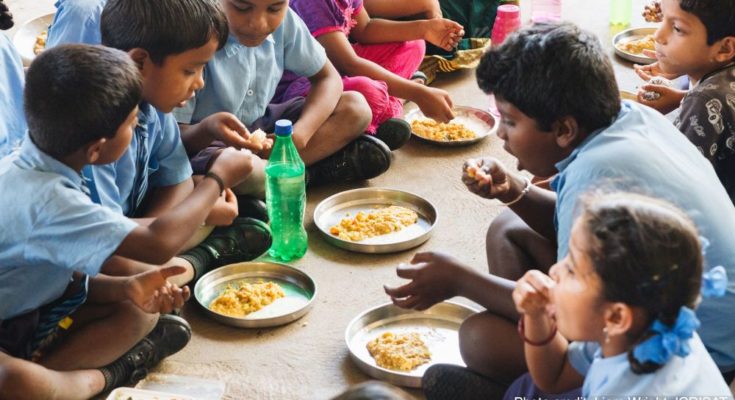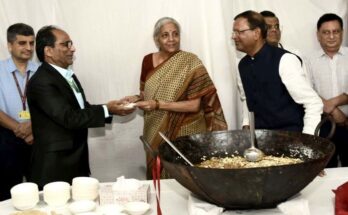Findings from a recently published feeding study with 1,500 children in Karnataka suggest that millet-based mid-day meals can boost growth by 50 percent in just three months. Children rated the meals, which were designed by scientists and chefs and included little millet as a rice substitute, over 4.5 on 5 for taste.
The findings of the study were released jointly by Prof Ramesh Chand, Member, NITI Aayog, and Dr Ashok Dalwai, Chair, Empowered Body, Doubling Farmers’ Income, Government of India, in New Delhi on Wednesday. The results were presented at the Tasting India Symposium later in the day.
“This is an example of not only a science-backed nutrition solution, but also a link between agriculture and nutrition. It is important now that we achieve mainstream consumption of millets and that they are not just for the elite,” said Prof Ramesh Chand.
“Millets are indeed superior cereals in terms of nutrition and also in terms of sustainability. They are ideally suited to address child undernutrition and fits very well in nature friendly production. Use of millets in various nutrition intervention programmes and in PDS will be of great help to address malnutrition and improve health,” Chand added.
Dr Ashok Dalwai emphasised, “Making it profitable for farmers to grow nutritious foods like millet has to be a key part of the doubling farmers’ income vision and millets are important in the rainfed areas for farmers to cope with climate change and water scarcity. I emphasise the need for harmonious consideration of three principal stakeholders: farmers, consumers, and ecology. We need a wholesome ecosystem system approach for long term sustainability.”
This Smart Food study, ‘Acceptance and impact of millet based mid-day meal on nutritional status of adolescent school going children in a peri-urban region of Karnataka state in India,’ published in the journal Nutrients, was undertaken by Akshaya Patra Foundation and International Crops Research Institute for the Semi-Arid Tropics (ICRISAT). Early adolescent school children in four villages—Thathaguni, Kagallipura, Allahali and Chensandra which are located around Bengaluru— participated in the study. Growth was assessed using anthropometry measurements, while sensory evaluations were made to determine acceptability.
“It is not good enough just to say we are going to add millets into the meal,” said Dr S Anitha, a nutritionist at ICRISAT and the study’s corresponding author. “The type of millet, its variety, how it is cooked and the foods it is combined with are some of the key elements that can make a difference in nutrition. For instance, the amount of iron available in a meal can be doubled by selecting the right variety of millet. This is the first known scientific study of millet based meals in a school feeding programme,” Anitha added.
The researchers gave the study group children meals including idli, khichdi, upma and bisibella bath in which rice was replaced by pearl millet (bajra), ragi (finger millet) or little millet (kutki). The anthropometric measurements at the end of the feeding programme were compared with that of control group children who consumed fortified rice with sambar.
“Akshaya Patra is always looking for ways to improve nutrition in mid-day meals. The millet meals were exceptionally successful and were really liked by the children. We appreciate the Karnataka government’s support, and with this positive result, we now hope this will garner the support needed to make nutritious millet based meals available to our future generations,” added Ajay Kavishwar, Head of Research at Akshaya Patra Foundation.
“This initiative also included developing guidelines on how to introduce millets into menus to maximise the nutrition benefits and likability. This is pertinent now given the renewed interest in millets,” said Ashok Jalagam, Smart Food Coordinator for Asia Pacific.
Call to policy makers
The study’s authors have called for policies that (1) Follow the lessons learnt on how to include millets into meals; (2) Create a level playing field for the pricing and availability of millets through minimum support price (MSP), public distribution scheme (PDS) and feeding programmes (MDMs, ICDS) that will benefit from not only including millets, but also from the approach taken to introduce them; (3) Go one step further and select millets by varieties in programmes, ensuring maximum nutritional value and impact and (4) promote millets in positive fun ways.
This is highly relevant now as millets have gained attention for their nutritional value and resilience in the face of water scarcity and climate change, making them a viable option for struggling farmers if markets can be further developed. The Government of India and various states like Karnataka and Odisha have led the cause to make millets a popular food choice. The Central government designated 2018 as ‘National Year of Millets’ and initiated a millet mission. NITI Aayog recently announced a pilot to include millets in the Integrated Child Development Services (ICDS) and MDM schemes.
“These results and guidelines developed from the study are equally important for any scheme addressing malnutrition or general health diets–whether that of governments, NGOs or private sector processors or caterers,” noted Joanna Kane-Potaka, Executive Director of Smart Food and Assistant Director General of ICRISAT.
“ICRISAT holds the world’s largest collections of millet genetic material and works closely with Indian Institute of Millets Research and other partners to improve millets by developing varieties having higher nutrient levels as well as the more conventional traits like yield and resilience,” commented Dr Peter Carberry, Director General, ICRISAT.
“Scientific research is essential to ensure the best solutions. This study has highlighted the need for research ranging from high end genomics that can halve the time needed for breeding the most nutritious millets through to social economics and marketing research that can test the best methods for achieving behaviour change towards more nutritious diets,” Carberry added.
Smart Food is a global initiative to bring foods that fulfil all criteria of being good for the people, the planet and the farmer into mainstream. The key objective of Smart Food is to diversify staples with Smart Foods, starting with millets and sorghum. Given that staples often constitute 70 percent of a meal and typically comprise of refined carbohydrate, hence little nutrition, Smart Foods can have a big impact.
Speaking on the occasion, Dr Vilas Tonapi, Director, IIMR said, “It is very important to recognise the wide difference in all the millets from nutritional value to cooking and processing suitability and taste. Indian Institute of Millets Research (IIMR) works on all the millets and across the whole value chain from breeding improved varieties to undertaking research on product development to operating an incubator for SMEs.”
“Our nutrition students were thrilled to be able to undertake the BMI (height, weight, arm length and arm circumference) measurements of the children. Our chefs and students alike have been inspired by the potential for millets and are creating new recipes and testing their nutrition values and undertaking sensory evaluations. So far the results are very positive,” said Priya Arjun, Head Food and Beverage, Head Nutrition Center, MS Ramaiah University of Applied Sciences.
Highlighting the nutritional value of millets, Dr Rajeev K Varshney, Research Program Director – Genetic gains, ICRISAT said, “Gut health (microbiomes) is an emerging science and critical for the absorption of nutrients. Millets have pre and probiotic properties and therefore they can naturally help in improving gut health. However, little is known about this area, and given that it can influence the final nutritional value of our food, more research is urgently needed.”




